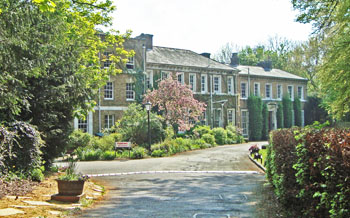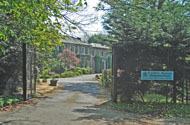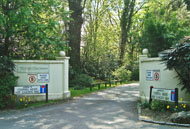Medical Rehabilitation Centre
Rehabilitation
In 1949 the North West Metropolitan Regional Hospital Board purchased Garston Manor, a large country house in 60 acres of grounds, located on the outskirts of Watford, for use as a medical rehabilitation unit.
The Garston Manor Medical Rehabilitation Centre opened in 1951 with accommodation for 60 patients. Both men and women were admitted, but the greater liability of men to injury at work or in road traffic accidents meant that they outnumbered women by five to one. The bedrooms were all on the first floor and patients could only be admitted if they could climb at least 27 stairs (this delayed the admission of certain orthopaedic cases, such as those who had hip replacements and those with multiple limb injuries). The ground floor contained lounges, dining rooms, a cafeteria and a large recreation room which was used for table tennis, television viewing, film shows and dances (held every week). The basement contained a billiards room.Patients were referred by the hospitals administered by the North West Metropolitan Hospital Board, as well as from those in London, the Home Counties and, occasionally, from the Midlands, East Anglia and Wales. Dockers were sent by the Medical Officers of the National Dock Labour Board from all over the country. More than half the patients had orthopaedic conditions - multiple limb fractures, nerve injuries, amputations, spinal injuries - or were recovering from knee or hip joint operations. Most were manual workers who needed a high degree of physical fitness in order to return to work. Medical cases included those with head injuries, hemiplegia (as a result of head injury or stroke), paraplegia, dockers with chronic bronchitis and patients with peripheral vascular disease necessitating amputation. The centre also treated a small number of those with rheumatoid arthritis, ankylosing spondylitis and other systemic disorders, but those with unstable disabilities, such as active rheumatoid arthritis or progressive neurological diseases, were deemed unlikely to benefit from the regimen. Patients with mental disease, excepting stable chronic schizophrenics, were also excluded as they benefitted little from treatment and also tended to upset the other patients. Psychopaths, hysterics and drug addicts (including chronic alcoholics) were also not admitted.
The patients were encouraged to look on Garston Manor as a temporary home rather than a hospital. They were allowed to go out in the evening, provided they returned at a reasonable hour, and many returned home for the weekends. Some were allowed to park their cars at the Centre. The patients elected their own committee to arrange entertainments and to deal with complaints; members of the committee met new patients and introduced them to life at the Centre. The average length of stay was six weeks, but varied according to disability.
The medical staff included two part-time consultants in physical medicine, a visiting orthopaedic surgeon and a psychiatrist, and a part-time senior registrar and registrar shared with the National Hospital for Nervous Diseases and the Middlesex Hospital. The Centre had no resident medical staff, but a local GP was on-call for emergencies. Nursing care was provided by part-time nursing Sisters, one of whom slept at the Centre at night.
The remedial centre was located some 150 yards (137 metres) from the manor house. The centre had a Physiotherapy Department with a therapeutic pool, a gymnasium, an Occupational Therapy Department and a few small remedial workshops. The remedial staff consisted of 3 physiotherapists, 3 remedial gymnasts and 2 occupational therapists. A speech therapist and a surgical appliance fitter attended weekly.
Out-patients were brought to the Centre by ambulance or collected from local stations by a minibus. Some used their own cars.
Treatment sessions were from 09.00 until 12 noon, and then after lunch from 14.00 to 17.00. Each patient was given an individual programme on admission, which was reviewed and altered frequently during their stay. The day was broken up into half-hour sessions, during which patients were allocated to the gymnasium, swimming pool or outdoor exercise. Those who initially had difficulty in walking progressed eventually from walking with crutches to walking with sticks, and could often dispose of walking aids altogether at the end of their stay. Those who would need to use public transport were able to practise mounting a stationary 'bus' in the grounds, and eventually were taken on public transport to the local shopping centres.
In 1956 a report by the Piercy Committee on Rehabilitation had drawn attention to the difficulty in deciding when medical rehabilitation had ended and industrial rehabilitation had begun. Medical rehabilitation is largely concerned with restoring patients to physical fitness as far as possible, or enabling them to cope with permanent disability by providing prosthetic limbs, wheelchairs and hand-controlled vehicles, or domestic aids, as well as making alterations to their homes. Industrial rehabilitation is concerned with finding jobs for disabled workers in industry or sheltered workshops, assessing the skills and aptitudes of those needing alternative work and providing vocational training for those who need new skills. The Committee recommended that two or three experimental combined units be established, in which treatment and work could proceed side by side.
Following negotiations with the Regional Hospital Board, the Ministry of Health and the Ministry of Labour, an Industrial Rehabilitation Unit was built in the grounds of Garston Manor - the first of the new combined centres. It opened in May 1968 with 60 places, a third of which were filled by patients transferred from the medical unit, initially for half a day while they continued their medical rehabilitation, but subsequently for the whole day. The remainder of the places were taken by rehabilitees from hospitals and employment exchanges in the southern and eastern parts of England, many living in a nearby industrial hostel.
The new unit was under the control of the Ministry of Labour (the Disabled Persons (Employment) Act, 1944, made industrial rehabilitation the responsibility of the Ministry of Labour). It contained workshops, which not only replaced those in the medical unit but also extended the range of facilities available. They provided production work in light engineering, bench fitting, machine operating, assembly work and carpentry. Heavy manual work was available both indoors and outdoors in the grounds. A clerical section assessed those who wished to do clerical work in the future. The unit was staffed by a chief occupational supervisor, workshop supervisors, an occupational psychologist, a social worker and a full-time Disabled Resettlement Officer.
In 1966 the Medical Rehabilitation Centre had 61 beds.
By 1975 it had 67 beds. Although now under the control of the South West Herts District Health Authority, part of the North West Thames Regional Health Authority, it remained linked with the Middlesex Hospital.
In 1985 the building was Grade II listed.
Gradually the number of beds declined, from 55 in 1987 to 48 in 1988, and to 35 in 1991.
The Centre came under the control of the West Herts Community Health (NHS) Trust in 1996. It closed in 1998 and services were transferred to St Albans City Hospital.
Present status (April 2011)
After the Centre closed, Garston Manor remained empty for some years until it was bought in 1997 for £500,000 for use as St Andrew's Montessori School.
The house was completely refurbished and has been renamed High Elms Manor, its original name until 1895, to avoid confusion with Garston Manor Special School on Horseshoe Lane. St Andrew's Montessori School is now known as High Elms Manor School.
The house is available as a venue for wedding receptions and corporate events. The grounds have been redeveloped for housing.

The building was Grade II listed in 1985.


Signage for St Andrew's Montessori Preparatory School at the entrance (left)and to High Elms Manor (right).
Medical and Industrial Rehabilitation
The Garston Manor Medical Rehabilitation Centre was the only one to have an industrial rehabilitation unit sited alongside it, as recommended by the Piercy Report. It was a successful experiment, allowing patients a gradual re-entry into an industrial environment or, where this had been too early, for the person to receive further medical or therapeutic care.
The experiment has never been repeated and occupational medicine is rarely taught in medical schools nowadays. Medical students know little of their patients' workplaces.
Chamberlain MA 2007 Work, disability and rehabilitation: making the best job of it. Clinical Medicine 7, 603-606.
Gloag D 1985 Occupational rehabilitation and return to work: 1 - General services. British Medical Journal (Clin Res Ed) 290, 1135-1138.
Mattingly S 1965 Industrial rehabilitation. British Medical Journal 2 (5467), 930-932.
Mattingley S 1968 Garston Manor: an experiment in rehabilitation. British Medical Journal 3 (5609), 46-49.
Mattingley S 1971 Results of combined medical and industrial rehabilitation at Garston Manor. Rheumatology and Physical Medicine 11, 193-198.
Mattingley S 1971 Rehabilitation of registered dock workers. Proceedings of the Royal Society of Medicine 64, 757-760.
Piercy, Lord 1956 Report of the Committee of Inquiry on the Rehabilitation, Training and Resettlement of Disabled Persons. Ministry of Labour, H.M.S.O.
http://countryhouses.wordpress.com
http://en.wikipedia.org
http://hansard.millbanksystems.com
http://hertfordshire.greatbritishlife.co.uk
www.britishlistedbuildings.co.uk
www.channel4.com
www.francisfrith.com
www.watfordobserver.co.uk (1)
www.watfordobserver.co.uk (2)
www.westhertshospitals.nhs.uk
Return to home page